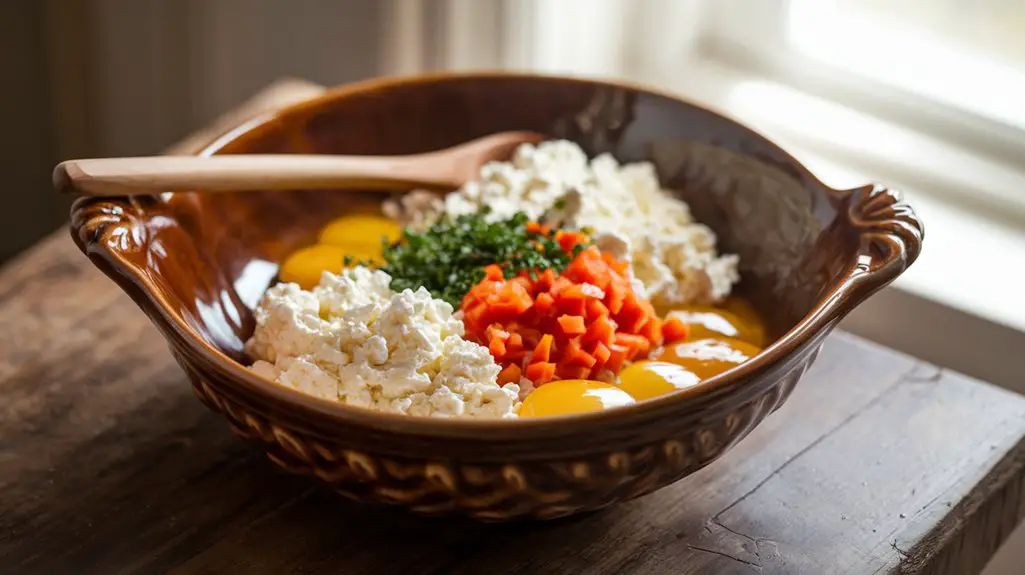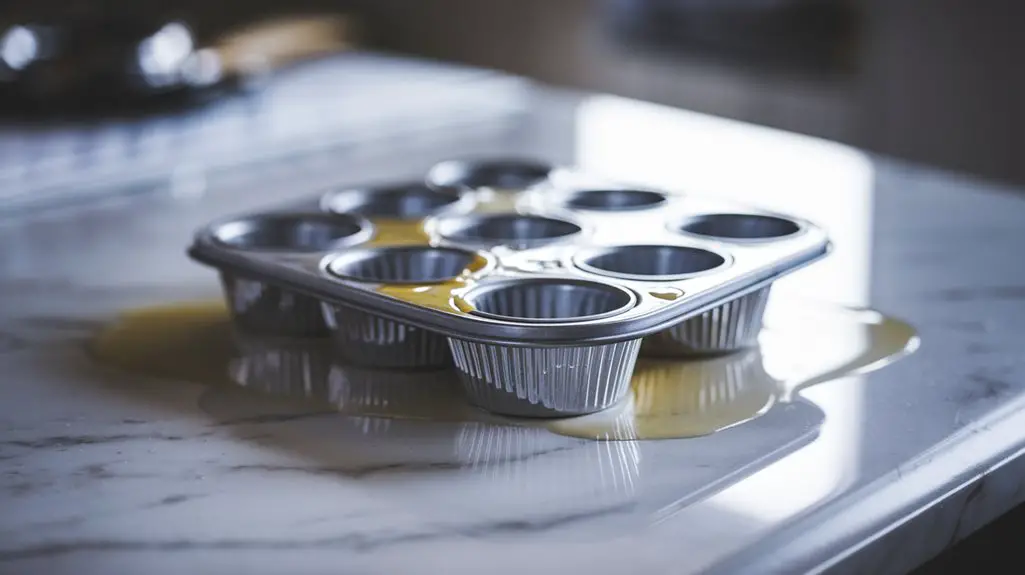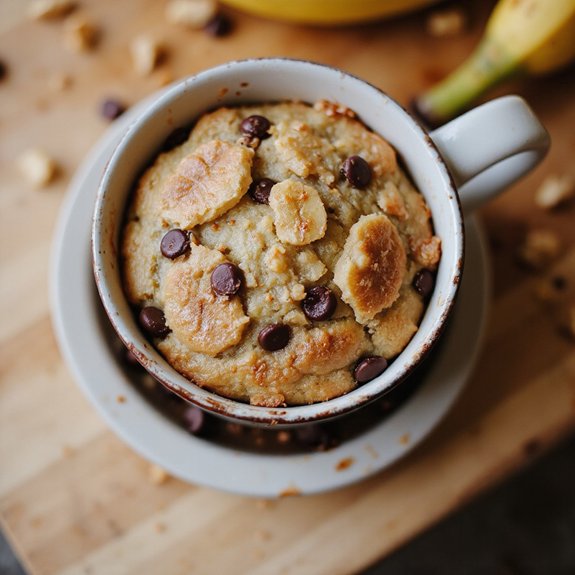Imagine you’re looking for a versatile dish that fits seamlessly into your meal prep routine.
Cottage Cheese Egg Bites might just be what you need. They’re easy to make and packed with protein, offering a creamy texture that many find irresistible.
With just a few ingredients, you can customize them to suit your taste, whether you prefer them loaded with veggies or a touch of savory meat.
But what makes these bites truly stand out? There’s more to discover about their surprising health benefits and unique preparation methods that might change how you view this humble snack.
History
Although Cottage Cheese Egg Bites have recently gained popularity as a convenient breakfast option, their roots can be traced back to traditional egg-based dishes that utilize dairy for enhanced flavor and texture.
Historically, frittatas and quiches incorporated cream or milk, enriching the egg mixture.
By substituting cottage cheese, you maintain the creaminess while boosting protein content.
Cottage cheese’s role extends beyond flavor; its moisture aids in achieving a tender crumb structure without the added fats of cream.
This innovation reflects culinary evolution, where efficiency meets nutrition.
Your use of precise measurements—such as a tablespoon of cottage cheese per egg—ensures consistency in texture and taste.
Understanding this evolution helps you appreciate the simplicity and ingenuity behind modern Cottage Cheese Egg Bites.
Recipe
Cottage Cheese Egg Bites are a delightful and nutritious breakfast option that combines the creamy texture of cottage cheese with the protein-rich goodness of eggs.
These savory bites are perfect for busy mornings, as they can be made ahead of time and warmed up quickly for a satisfying meal on the go.
Packed with flavor, they can be customized with your favorite herbs, spices, and add-ins to suit your taste.
This recipe is not only versatile but also incredibly easy to prepare, making it a favorite among families and individuals looking for a quick breakfast solution.
Cottage Cheese Egg Bites can be enjoyed plain or paired with a side of fresh fruit or a green salad for a more complete meal.
Whether you’re preparing them for a leisurely weekend brunch or a quick weekday breakfast, these egg bites are sure to become a staple in your meal rotation.
Ingredients:
- Eggs
- Cottage cheese
- Shredded cheese (e.g., cheddar or mozzarella)
- Salt
- Pepper
- Baking powder
- Optional: chopped vegetables (e.g., spinach, bell peppers) or cooked bacon/sausage
To prepare Cottage Cheese Egg Bites, begin by preheating your oven to 350°F (175°C).
In a mixing bowl, whisk together eggs, cottage cheese, shredded cheese, salt, pepper, and baking powder until well combined.
If desired, fold in chopped vegetables or cooked bacon/sausage for added flavor and texture.
Grease a muffin tin and evenly distribute the egg mixture among the cups.
Bake in the preheated oven for 20-25 minutes, or until the egg bites are set and lightly golden on top. Allow them to cool slightly before removing them from the tin.
For the best results, use fresh eggs and high-quality cottage cheese to enhance the flavor of your egg bites.
You can experiment with different cheese varieties and add-ins to create your own signature version.
If you’re making these ahead of time, store them in an airtight container in the refrigerator for up to four days.
Reheat them in the microwave for a quick and easy breakfast. If you prefer a crispy texture, try placing them under the broiler for a minute or two before serving.
Cooking Steps
Begin by preheating your oven to 350°F (175°C) to guarantee even cooking.
In a mixing bowl, combine eggs, cottage cheese, shredded cheese, salt, pepper, and baking powder until the mixture is smooth and uniform.
Thoroughly grease your muffin tin to prevent sticking, then distribute the mixture evenly and bake until the tops are golden brown, letting them cool slightly before removing from the tin.
Step 1. Preheat Oven to 350°F

Preheat your oven to 350°F (175°C) to guarantee even cooking for your Cottage Cheese Egg Bites.
This temperature assures your egg bites achieve the perfect balance between a firm yet tender texture.
The heat circulates evenly, allowing the proteins in the eggs to set without overcooking.
Accurate preheating is essential, so confirm with an oven thermometer if necessary.
Position your oven rack in the center to promote uniform heat distribution. This placement prevents the bottom from over-browning while assuring the tops cook perfectly.
If your oven has a convection setting, use it for enhanced air circulation, which can improve overall cooking time and consistency.
However, if using convection, monitor closely as cooking times may vary slightly.
Step 2. Combine Ingredients in Bowl

With your oven now at the ideal temperature, focus shifts to assembling the ingredients for your Cottage Cheese Egg Bites.
Begin by cracking six large eggs into a mixing bowl. Whisk them vigorously until the yolks and whites are fully combined.
Add one cup of creamy cottage cheese, half a cup of shredded cheddar, a quarter teaspoon of salt, and a pinch of freshly ground pepper.
Finally, incorporate one teaspoon of baking powder to guarantee fluffiness.
For additional texture and flavor, gently fold in any optional add-ins like chopped bell peppers or crispy bacon bits.
Here’s a glimpse of what you’ll need:
| Ingredient | Measurement | Purpose |
|---|---|---|
| Eggs | 6 large | Protein base |
| Cottage cheese | 1 cup | Creaminess |
| Shredded cheese | ½ cup | Richness |
| Salt | ¼ teaspoon | Flavor balance |
| Baking powder | 1 teaspoon | Leavening agent |
Mix thoroughly, guaranteeing a cohesive blend.
Step 3. Grease Muffin Tin Thoroughly

Before proceeding with the baking, make certain your muffin tin is thoroughly greased to prevent sticking.
Use a pastry brush to apply a thin, even layer of oil or melted butter to each cup. Opt for high-smoke-point oils like canola or vegetable oil for best results.
Verify that you coat both the bottom and sides meticulously.
This step is essential, as it facilitates easy release and maintains the structural integrity of your Cottage Cheese Egg Bites.
Alternatively, you can use non-stick cooking spray for convenience.
Measure approximately 1 teaspoon of oil per muffin cup to achieve adequate coverage.
Once greased, visually inspect each cup to confirm no areas are left untreated, guaranteeing a seamless baking experience.
Step 4. Bake Until Golden Brown

Slide the prepared muffin tin into the preheated oven, set to 350°F (175°C), ensuring even heat distribution.
Bake for 20-25 minutes until the egg bites achieve a golden-brown hue, indicating doneness.
Utilize a timer to track the duration precisely. As you bake, monitor the tops; they should rise slightly and firm up.
The center should no longer be jiggly, a sign of proper coagulation.
Once they’re beautifully browned, resist the urge to open the oven prematurely, maintaining consistent thermal conditions.
Step 5. Cool Before Removing Tin

Once you’ve achieved the desired golden-brown hue on your Cottage Cheese Egg Bites, confirm they remain in the oven to maintain their structural integrity.
Allow them to cool for approximately 5 minutes. This brief resting period confirms the protein matrix in the eggs sets fully, preventing collapse when removed from the tin.
Avoid hastily extracting the bites; premature removal can lead to tearing or crumbling.
Utilize a small offset spatula or a thin, flexible knife to gently loosen the edges of each egg bite.
Carefully lift them out, ensuring even pressure to avoid breaking the delicate texture.
Cooling also enhances flavor development, allowing the cheese and seasoning to meld.
Patience at this stage rewards you with perfectly intact and flavorful egg bites.
Final Thoughts
As you bring your culinary adventure with Cottage Cheese Egg Bites to a close, it’s important to appreciate the versatility and nutritional benefits these bites offer.
They’re an excellent source of protein, thanks to the eggs and cottage cheese.
Each bite can be customized with precise additions—try 30 grams of spinach or 15 grams of diced bell peppers for extra nutrients.
A pinch of salt (about 1 gram) enhances flavor without overpowering.





